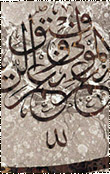| |

| |
 |
| Script |
| |
 |
| Allahu Veliyyu't |
|
|

 |
3
OF 3 |
|
 Now
let us see what happened to the ta'līk script under the Ottomans.
This script which had been used in Turkey since the second half
of the fifteenth century rose to prominence after the renowned master
of ta'līk Imādü'l-Hasenī (?-1024/1615) had demonstrated its potential.
Turkish calligraphers took to this style of ta'līk with such enthusiasm
that it became customary to refer to calligraphers who excelled
in it as Imād-i Rūm ("the Imād of Anatolia"). In the 18th
century, Mehmed Es'ad Efendi (?-1213/1798), a remarkable calligrapher
who was known by the cognomen of Yesārī ("left-handed")
because the right side of his body was paralysed obliging him to
write with his left hand, selected Imād's loveliest characters as
the basis of his own manner. In this way a Turkish school of ta'līk
was born. His son Yesārizāde Mustafa Izzet Efendi (?-1265/1849)
set this manner on a foundation of detailed rules, and developed
a style of celī ta'līk in Istanbul which had no match even in Persia.
Sāmi Efendi, who was a master of ta'līk and celī ta'līk, as well
as celī sülüs, passed on this Turkish style in its superlative form
to his pupils Hulūsi Yazgan (1286-1358/1869-1940) and Necmeddin
Okyay (1300-1396/1883-1976). Now
let us see what happened to the ta'līk script under the Ottomans.
This script which had been used in Turkey since the second half
of the fifteenth century rose to prominence after the renowned master
of ta'līk Imādü'l-Hasenī (?-1024/1615) had demonstrated its potential.
Turkish calligraphers took to this style of ta'līk with such enthusiasm
that it became customary to refer to calligraphers who excelled
in it as Imād-i Rūm ("the Imād of Anatolia"). In the 18th
century, Mehmed Es'ad Efendi (?-1213/1798), a remarkable calligrapher
who was known by the cognomen of Yesārī ("left-handed")
because the right side of his body was paralysed obliging him to
write with his left hand, selected Imād's loveliest characters as
the basis of his own manner. In this way a Turkish school of ta'līk
was born. His son Yesārizāde Mustafa Izzet Efendi (?-1265/1849)
set this manner on a foundation of detailed rules, and developed
a style of celī ta'līk in Istanbul which had no match even in Persia.
Sāmi Efendi, who was a master of ta'līk and celī ta'līk, as well
as celī sülüs, passed on this Turkish style in its superlative form
to his pupils Hulūsi Yazgan (1286-1358/1869-1940) and Necmeddin
Okyay (1300-1396/1883-1976).
 As
can be seen, a continual process of selection and refinement went
on in the stylistic evolution of Turkish calligraphy, but without
distortion of the essential forms. While western influence brought
about a degradation in Turkish architecture, music, painting and
decoration, no similar decline took place in calligraphy. This can
be attributed to three factors: As
can be seen, a continual process of selection and refinement went
on in the stylistic evolution of Turkish calligraphy, but without
distortion of the essential forms. While western influence brought
about a degradation in Turkish architecture, music, painting and
decoration, no similar decline took place in calligraphy. This can
be attributed to three factors:
1. The absence of a comparable art in Europe to exert an
influence,
2. The continuation of the master-apprentice system whereby
techniques and aesthetic concepts were transmitted from generation
to generation,
3. The capacity of this art for self-renewal.
There is a widespread adage in Muslim countries to the effect that,
"The Koran descended in the Hejaz, was read in Egypt, and written
in Istanbul." There is no denying that it was in Istanbul that
the Koranic scriptures appeared as works of art on paper. In the
same way, the hadīs or oral traditions of the Prophet took their
finest written form here, and the list could be extended. Divans
and fermān, and carved inscriptions on marble fountains and tombstones
were all inscribed with a beauty worthy of Istanbul's reputation
as "beldetün tayyibetün" ("the most beautiful city")
by calligraphers too numerous to cite by name here.
After this brief account, I will mention two scripts not regarded
as calligraphic hands in the past:
RIK'A
Despite the close resemblance between their names, rik'a bears no
resemblance of form to rika', which is the sixth of the aklām-i
sitte scripts. The rik'a script was that in daily use by every literate
Ottoman Turk, and was written with a reed pen whose nib was a maximum
of 1 mm in width. Until the 19th century, the style of rik'a depended
entirely on the whim of each writer, but this situation ended  with
the advent of Bābiālī rik'asi, which was originally devised by Mümtaz
Efendi (1225-1287/1810-1872) and used by government offices. The
speed of writing this script was increased by means of simplifying
the characters. Later in the century, Mehmed Izzet Efendi (1257-1302/1841-1903)
developed another form of rik'a based on strict rules. Known as
Izzet Efendi rik'asi, this script was subsequently adopted widely
in the Arab world. with
the advent of Bābiālī rik'asi, which was originally devised by Mümtaz
Efendi (1225-1287/1810-1872) and used by government offices. The
speed of writing this script was increased by means of simplifying
the characters. Later in the century, Mehmed Izzet Efendi (1257-1302/1841-1903)
developed another form of rik'a based on strict rules. Known as
Izzet Efendi rik'asi, this script was subsequently adopted widely
in the Arab world.
SIYĀKAT
The script known as siyākat was reserved for Treasury documents
and title deeds in the Ottoman Empire. It was so extremely difficult
to read and write that it could more accurately perhaps be termed
a cipher, and was intended as a prevention measure against forgery.
It was never employed with artistic intent.
 |
3
OF 3 |
|
|
|


